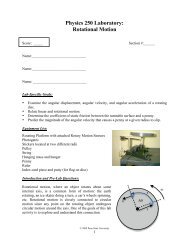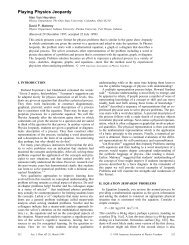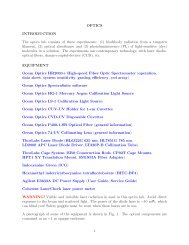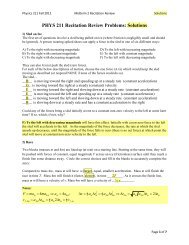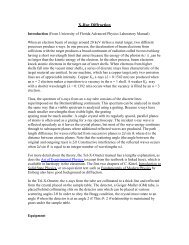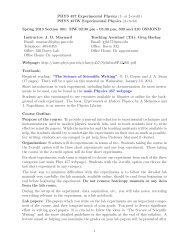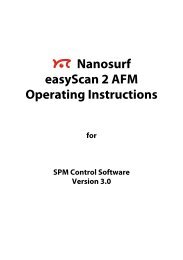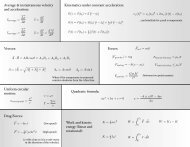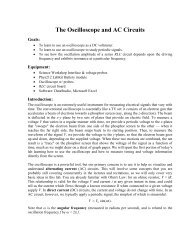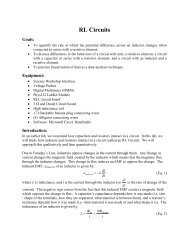Diode laser spectroscopy
Diode laser spectroscopy
Diode laser spectroscopy
You also want an ePaper? Increase the reach of your titles
YUMPU automatically turns print PDFs into web optimized ePapers that Google loves.
<strong>Diode</strong> <strong>laser</strong> <strong>spectroscopy</strong><br />
Introduction:<br />
In this lab you will utilize a tunable diode <strong>laser</strong> to explore the absorption spectra of the Rubidium atom.<br />
The diode <strong>laser</strong> emits near IR light at a wavelength of 785 nm (382,000 GHz), and is directed through a<br />
Rubidium gas. The energy of this <strong>laser</strong> frequency is very near the excitation energies of the Rubidium<br />
atom. By scanning the frequency of the diode <strong>laser</strong> you will quantify the Doppler broadened resonant<br />
absorption spectra of the <strong>laser</strong> light by the rubidium atom in its excited states and the hyperfine splitting<br />
of those excited energy level dues to different nuclear spins.<br />
You will also explore the propagation of electromagnetic waves through a gas of Rubidium atoms near<br />
resonance. You will measure the temperature dependence of electromagnetic wave absorption (and via<br />
the Clausius-Clapeyron Relation measure Rubidium’s latent heat of vaporization) and calculate and<br />
observe the complex (real and imaginary components ) nature of the index of refraction of the gas using a<br />
Mach-Zehnder interferometer, which you will build.<br />
References:<br />
Teachspin Manual (2008 edition)<br />
Chapter 1 Laser Physics<br />
Chapter 2: Spectroscopy<br />
Chapter 3 Getting Started<br />
Chapter 4: Experiments Caltech Laboratory Manuals<br />
Chapter 5: Apparatus<br />
Zeeman Splitting Article Bowie et. al. 1995 (note this is for the D1 line and we probe the D2 line of<br />
Rubidium but the physics is the same)<br />
A. C. Melissinos and J. Napolitano. Experiments in Modern Physics (2 nd edition) Academic Press, New<br />
York.
Theoretical Background:<br />
The majority of the theoretical background behind using Doppler broadened Saturated Absorption<br />
Spectroscopy to study Rubidium atoms can be found in Chapter 2 of the Teach Spin Manual<br />
(Spectroscopy ). This includes discussion of how absorption peaks (and crossover resonances) come to<br />
be, as well as the quantum mechanical background of the transitions in Rubidium. Below is a summary<br />
of some of the useful information presented with little explanation.<br />
Rubidium transitions:<br />
From (Caltech Manual chapter 4.1):<br />
Rubidium has two stable isotopes: 85 Rb (72 percent abundance), with nuclear spin quantum number I =<br />
5/2, and 87 Rb (28 percent abundance), with I = 3/2. The different energy levels are labeled by “term<br />
states”, with the notation 2S+1 L’ J , where S is the spin quantum number, L’ is the spectroscopic notation for<br />
the angular momentum quantum number (i. e. S, P,D, . . ., for orbital angular momentum quantum<br />
number L = 0, 1, 2, . . .), and J = L+S is the total angular momentum quantum number. For the ground<br />
state of rubidium S = 1/2 (since only a single electron contributes), and L = 0, giving J = 1/2 and the<br />
ground state 2S 1/2 . For the first excited state we have S = 1/2, and L = 1, giving J = 1/2 or J = 3/2, so there<br />
are two excited states 2P 1/2 and 2P 3/2 . Spin-orbit coupling lifts splits the otherwise degenerate P 1/2 and P 3/2<br />
levels. (See any good quantum mechanics or atomic physics text for a discussion of spin-orbit coupling.)<br />
The dominant term in the interaction between the nuclear spin and the electron gives rise to the magnetic<br />
hyperfine splitting (this is described in many quantum mechanics textbooks):<br />
∆E =(C/2) [F(F +1) − I(I +1) − J(J +1)]<br />
where F = I + J is the total angular momentum quantum number including nuclear spin, and C is the<br />
“hyperfine structure constant.”<br />
Figure 1: (Left) Level diagrams for the D2 lines of the two stable rubidium isotopes.<br />
(Right) Typical absorption spectrum for a rubidium vapor cell, with the different lines shown. (From Teach Spin Manual<br />
Chapter 2)
Figure 8: Rubidium energy level diagrams showing hyperfine splittings of the ground and excited states. Selection rules<br />
for transitions are ∆F=0,+/-1.<br />
Experimental apparatus:
Experimental setup shown above is enclosed within the Plexiglas box. Take some time to identify the<br />
different parts (but don’t bump any of the optics). They should be aligned fairly well at this point, but you<br />
may have to do some alignment as part of your lab work.<br />
Our specific setup is shown on the following page.<br />
In addition to the setup above, there is also:<br />
1) The Laser control box (which controls <strong>laser</strong> temperature, current, and scanning frequencies)<br />
2) CCD camera and TV<br />
3) Digital Oscilloscope<br />
4) Keithley multimeter<br />
5) Notes on the <strong>laser</strong>: The <strong>laser</strong> should be aligned within the cavity. Do not remove its enclosure<br />
box. If you have difficulty observing the <strong>laser</strong>, or any of the features, it is mostly likely because<br />
of alignment of the optics, or settings on the electronics. You should be able to identify which and<br />
how to remedy the situation.
90/10 bs<br />
90/10 bs<br />
mirror<br />
mirror<br />
50/50 bs<br />
mirror<br />
photodiodes<br />
interferometer<br />
50/50 bs<br />
mirror<br />
mirror
Safety:<br />
• Before beginning this experiment Penn State Requires that all students operating a class IIIB <strong>laser</strong><br />
take the online <strong>laser</strong> safety training found by following the instructions here:<br />
http://www.ehs.psu.edu/radprot/training_and_quiz.cfm<br />
After your training is complete include a copy of your training certificate in the back of the <strong>Diode</strong><br />
<strong>laser</strong> <strong>spectroscopy</strong> 3-ring binder and add your name to the list of those who are specifically<br />
trained for this experiment on the Laser Training Sheet at the back of the binder.<br />
• Optical setup is enclosed within a Plexiglas case to prevent stray <strong>laser</strong> light from exiting the<br />
experimental area.<br />
• Note, the <strong>laser</strong> is infrared and you can’t see it directly, so there is no blink reflex if the <strong>laser</strong> hits<br />
your eye, so you must wear safety goggles whenever the <strong>laser</strong> is on and the Plexiglas lid is off.<br />
• Never put your head at eye level with the <strong>laser</strong> ON. Always look at the setup from above.<br />
• When turning on the control box always make sure the LASER ON switch is turned off (down).<br />
• Also, never touch the mirrors/beam splitters/optics devices, the surfaces will scratch when<br />
cleaned and this can cause the <strong>laser</strong> to reflect improperly.<br />
The experiment:<br />
*Note below is an abbreviated description of how to measure the Rubidium spectrum. If the setup<br />
is reasonably aligned this description will be sufficient. Otherwise refer to the Teachspin Manual<br />
Chapter 3 and Chapter 4.1 (Caltech Experiment Manual).<br />
Finding the <strong>laser</strong> beam: Place a business card in a holder between beam splitter 1 and beam splitter 2.<br />
Also place a business card between photodiode detector 3 and the interferometer beam splitter. You will<br />
not need this part of the optics path at this point. Turn on the control box and set the temperature to 50C,<br />
wait until the temperature is stabilized, and then turn on the <strong>laser</strong> with the current dial at zero. Using the<br />
IR viewing card, place the card directly in front of the <strong>laser</strong> output and slowly turn on the current until<br />
you can see the orange spot on the card. (You may remove the neutral density filter directly in front of the<br />
<strong>laser</strong>). This is how you will locate the <strong>laser</strong> beam, as you can’t see it with your eye. Now turn the <strong>laser</strong> off<br />
again (no need to turn the current back down).<br />
1) Varying the <strong>laser</strong> current:<br />
a. Find the lasing current. To do this, focus the TV camera on the card. Dim the room<br />
lights and turn the <strong>laser</strong> current to zero. Now increase the current while watching the<br />
TV monitor. You will see a light spot that becomes slightly brighter as you increase<br />
the current. Your diode <strong>laser</strong> is below threshold, it is not lasing, but only acting as an<br />
LED. As you continue to increase the current you will observe a sudden brightening<br />
of the beam spot and the appearance of a speckle pattern characteristic of lasing.<br />
Adjust the current so that the <strong>laser</strong> is just above threshold. You can measure the <strong>laser</strong><br />
current with a voltmeter. A diode current of 50 mA will give 5.0 Volt output on the<br />
LASER CURRENT in the MONITORS section. You can compare your measured<br />
value with the threshold current recorded on your data sheet. A lower threshold<br />
current represents better optical alignment. If the threshold current is significantly
different from that on the data sheet (1 st page of manual), the <strong>laser</strong> cavity will need to<br />
be re-aligned.<br />
2) Observing Rubidium Fluorescence:<br />
a. Move the business card from between the beam splitters to be between beam splitter 2<br />
and the first mirror. Use the orange card to assure the beam is hitting the business card.<br />
For now we will focus on this simple part of the experimental setup:<br />
b. Check that the 2 (why are there 2) <strong>laser</strong> beams enter the Rubidium gas and comes out the<br />
other side (The neutral density filter can still be out at this point). Point the camera so it<br />
looks into the Rb cell from the Side Hole in the cell heater. If you place the camera<br />
up on the base of the cell holder you can position the camera so that it abuts the glass<br />
holder surrounding the Rb cell.<br />
c. Observe the RAMP OUTPUT of the RAMP GENERATOR module on an oscilloscope using<br />
the RAMP GENERATOR SYNC. OUTPUT as a trigger. Observe the output on the ‘scope as<br />
you adjust the RAMP GENERATOR settings.<br />
d. Use the RAMP GENERATOR and PIEZO CONTROLLER to Set the Frequency Sweep<br />
i. Turn the ramp amplitude down and connect the RAMP OUTPUT from the<br />
oscilloscope to the modulation input connection on the PIEZO CONTROLLER<br />
MODULE.<br />
ii. Connect the MONITOR OUTPUT of the PIEZO to Channel 1 of the oscilloscope.<br />
Turn the piezo OUTPUT OFFSET knob to zero. (The OUTPUT OFFSET<br />
changes the DC level of the monitor output. It does not change the voltage<br />
applied to the piezo stack.<br />
iii. Set the ramp generator frequency to about 10 Hz. Turn the piezo<br />
ATTENUATOR knob to one (1). Set the ramp generator AMPLITUDE knob<br />
to ten (10) and use the DC OFFSET knob of piezo controller to produce a<br />
large-amplitude triangle wave that is not clipped at the top or bottom. The<br />
piezo MONITOR OUTPUT should have a signal that runs from about 3 volts<br />
to about 8 volts. (You should know what the piezo is doing before you move<br />
on)<br />
e. Find the minimum <strong>laser</strong> current that creates rubidium fluorescence, and compare it to<br />
the value on the front page of the manual.<br />
3) Rubidium Doppler Broadened absorption peaks<br />
a. Check that each of the 2 beams are going to detector 1 and detector 2, respectively. At<br />
this point you should return the neutral density filter to its location. Using detector 2,<br />
view the output of the Photodiode detector on the ‘scope on channel 2. The signal from<br />
the Photodiode Detector is negative and saturates at about -11.0 volts. If the signal is<br />
saturated turn down the gain on the back of the photodiode until you see a signal. For<br />
the best performance you want the PD Gain to be as high as possible without<br />
saturating the PD, a signal level of 2 to 6 volts is reasonable. Block the beam with
your hand to convince yourself that the PD is detecting the transmitted <strong>laser</strong> light.<br />
You may have to wiggle the photodiode to maximize the signal going to the detector.<br />
You should see a ‘scope signal that looks something like this:<br />
b. The absorption dips in your trace are interrupted by various “mode hops” – why do<br />
these occur? Observe how the signal changes when you vary the <strong>laser</strong> current and the<br />
piezo drive parameters. With proper adjustment you should be able to set a scan that<br />
covers the first three lines in the absorption spectrum. (You should understand the<br />
physics of why these absorption peaks exist, and why they have some width)<br />
c. Using Simultaneous Current and Piezo Modulation to produce a larger scan range<br />
without mode hops.<br />
i. Set the <strong>laser</strong> CURRENT ATTENUATOR knob to zero. Attach the BNC splitter<br />
“F” connector to the RAMP OUTPUT on the RAMP GENERATOR. Plug one BNC<br />
from the RAMP OUTPUT to the MODULATION INPUT of the PIEZO CONTROLLER,<br />
and the second BNC from RAMP OUTPUT to the CURRENT MODULATION INPUT.<br />
ii. Turn the ramp generator amplitude up to maximum, and watch what happens<br />
when you turn up the current attenuator knob. With some tweaking you<br />
should be able to produce a full trace over the Rb spectrum.<br />
a. Record the spectra and measure frequency shifts between absorption peaks and peak<br />
widths.<br />
i. To do this you will need to calibrate the observed spectra with the interference<br />
fringes measured with the Michelson Interferometer (detector 3). You will have<br />
to remove the beam block in front of detector 3, and make sure the detector is<br />
positioned to see the <strong>laser</strong> beam, and adjust the gain on the photodiode to observe<br />
the fringe pattern. You should get something like the figure below on the ’scope<br />
if you are doing everything right:
i. You may need to adjust and align the optics of the Michelson Interferometer.<br />
To setup and align the Michelson Interferometer follow the steps in the manual<br />
(pages 3.26-3.30 of Chapter 3).<br />
ii. Once you have the Interferometer aligned, return the <strong>laser</strong> frequency to<br />
scanning mode- you should observe oscillations on the photodiode output<br />
shown on the oscilloscope. When a beam travels a distance L it picks up a<br />
phase 2πL/λ, so the electric field becomes ϕ<br />
iii.<br />
When the beam is split in the interferometer, the two parts are sent down the two<br />
arms, making the combined electric field<br />
E = E arm1 + E arm2 = E 0 e iωt( e i4πL 1 /λ + e i4πL2/λ )<br />
where L1 and L2 are the two arm lengths. The additional factor of two comes<br />
from the fact that the beam goes down the arm and back again. Squaring this to<br />
get the intensity we have<br />
I ~(e i4πL1/λ + e i4πL2/λ ) 2 ~ 1 + cos(4π∆L/λ)<br />
where ∆L = L1 − L2. If the <strong>laser</strong> frequency is constant, then the fringe pattern<br />
goes through one cycle every time the arm length changes by λ/2. If ∆L is fixed,<br />
E0eiωteiϕ<br />
what is the fringe period in MHz?<br />
Use the two oscilloscope traces to plot the interferometer fringes and the<br />
saturated absorption spectra at the same time, as you scan the <strong>laser</strong> frequency.<br />
You will use the Michelson Interferometer in the next step as well.<br />
=<br />
E =<br />
4) Observing the Saturated Absorption Spectra and Measuring the hyperfine splitting of<br />
Rubidium:<br />
a. From the non-saturated absorption spectra you should have noticed there are four excited<br />
energy states of Rubidium which you can probe with the <strong>laser</strong>. Each of these excited<br />
energy states has a hyperfine splitting due to nuclear spin states. The frequencies of these<br />
hyperfine states are observed as spikes in the absorption peaks (why are they spikes?).<br />
Added features called crossover resonances are also observed. These are<br />
additional narrow absorption dips arising because several upper or lower energy<br />
levels are close enough in energy that their Doppler-broadened profiles overlap<br />
creating an extra absorption spike between each of the expected peaks. Before you<br />
measure the hyperfine splitting of each of the four excited states, you should make 4<br />
graphs (one for each absorption peak) showing the expected frequency peaks, including
the crossover peaks for each of the four possible transition scenarios given that the<br />
selection rule is ∆F=0,+/-1. Crossover peaks are found half-way between each of the<br />
expected peaks (ν 1 +ν 2 )/2 for two absorption peaks of frequency ν 1 and ν 2 . Refer to the<br />
manual section on Spectroscopy for an explanation of the quantum mechanics involved,<br />
and for hints about crossover resonances.<br />
b. Re-connect the current modulation for this part of the experiment. Remove beam block<br />
between the second beam splitter and the first mirror. Chances are you will have to align<br />
the optic such that there are three beams passing through the rubidium chamber, two<br />
weak probe beams which are split of the 90/10 beamsplitter, and a third which is directed<br />
back through the rubidium chamber which acts as a pump beam. You should know what<br />
the roles are of these two beams. The resulting SAS spectra will be observed in the<br />
photodiode detector #1. You may observe this directly on the ‘scope.<br />
c. Expand the scale so that you can observe the two large absorption features. If your<br />
beams are close to being aligned, you will start to see some sharp spikes within the<br />
broad absorptions – you should know why you see spikes, ie, why has the absorption<br />
decreased? If they are not well aligned, you will have to re-align the beams using the<br />
instructions in the manual. You may now try to maximize the size of these spikes by<br />
gently wiggling the adjustment screws on the mirrors and the 50/50 BS.<br />
d. Compare the spectra observed in Photodiode 1 to that in Photodiode 2. It is useful to use<br />
the detector electronics section of your electronics box to isolate that difference<br />
between these two signals. Put the signal from Detector 1 into the minus input and<br />
that from Detector 2 into the plus input of the detector section of the electronics box.<br />
Attach the monitor output to the ‘scope. Set the plus balance control to zero and the<br />
minus balance control to one and observe the signal from Detector 1 on the ‘scope.<br />
Adjust the gain on Detector 1 so that you have a large signal (several volts) but not so<br />
large as to saturate the detector (maximum signal less than 10 volts). Now, set the<br />
plus balance to one and the minus balance to zero and observe the signal form<br />
Detector 2. It will be inverted, with negative voltage values. Again adjust the gain of<br />
Detector 2 for a signal level that is comparable to that seen by Detector 1. Because<br />
the beam going to Detector 2 is not attenuated by the 50/50 beam splitter, the gain<br />
needed on Detector 2 will be less than that of Detector 1.<br />
e. Now set both balance knobs to one and then reduce the balance on the larger signal so<br />
that the Doppler broadened background is removed. This subtraction is never perfect,<br />
so there will always be some residual broad absorption signal remaining. You may<br />
now raise the gain setting on the difference signal and bring the SAS spikes up to the<br />
volt level.<br />
f. Measure the hyperfine splitting for each of the 4 Doppler broadened absorption lines. (To<br />
get a good picture of the spectra for each of the 4 lines, it is useful to tune the piezo<br />
voltage slightly until you see one line clearly (on the left of the o-scope), and then<br />
increase the resolution on the scope, and then optimize the electronic subtraction.<br />
Quantify the frequency shifts using the Michelson Interferometer.<br />
5) Measuring the Zeeman splitting of the magnetic moments of Rubidium:<br />
The 10 Ohm Helmholtz coils surrounding the Rubidium chamber can be used to create a<br />
magnetic field up to 10 mT when 3A of current are supplied to them. Using the voltage source<br />
available apply a minimum amount of current to the Helmholtz coils in order to observe magnetic<br />
field induced splitting of the hyperfine split lines. Your goal should be to try to discern the<br />
splitting due to the different magnetic moments available for the excited Rubidium atoms. An
excellent reference is the published paper included in the manual on the Zeeman Effect in<br />
Rubidium. By measuring the change in energy of a magnetically induced absorption peak as a<br />
function of magnetic field, you might be able to experimentally measure g the gyromagnetic ratio<br />
which relates energy to magnetic field via:<br />
∆E= g F µ b B M F ,<br />
where<br />
g F =g J (F(F+1)+J(J+1)-I(I+1))/[2F(F+1)]<br />
and M F is the magnetic quantum number. Allowed transitions are determined by whether the<br />
photons are left (∆M F =+1) or right (∆M F =-1) cicularly polarized.<br />
6) Interferometric Measurement of Resonant Absorption and Refractive Index in Rubidium<br />
a. NOTE: often other groups are using the same apparatus. Make sure to discuss with all<br />
student groups before changing the optical setup.<br />
b. Before you do this experiment you should complete problems #1 and #2 in the Caltech<br />
experiment manual with the same title (found in the Teach-Spin manual section 4.2).<br />
c. Measure temperature dependence of the fractional absorption (use the 85a line) of<br />
Rubidium to calculate the latent heat of vaporization of Rubidium for one peak in the<br />
absorption spectra. (See attached pages) You will have to disconnect the current sweep to<br />
do this measurement. Block the pump beam before it enters beamsplitter #2, and use the<br />
probe beam entering detector #2. You should also chose one temperature and vary the<br />
<strong>laser</strong> current to measure the current dependence of the fractional absorption.<br />
d. To measure the frequency dependence of the index of refraction you will need to rearrange<br />
and align the optics to create the Mach-Zehnder interferometer. This is most<br />
easily done by replacing beamsplitter #1 in the diagram with a 50/50 beam splitter,<br />
removing beamsplitter #2, and switching the locations of beamsplitter #3 and mirror #2<br />
(not the one in the Michelson interferometer).<br />
e. To align the interferometer, turn off the frequency and current scanning on the electronics<br />
box, and remove the rubidium chamber (after assuring that the <strong>laser</strong> goes through the<br />
rubidium chamber’s window). Follow instructions in the manual to align the<br />
interferometer. After you have the two beams parallel and overlapping, move detector #3<br />
to intercept the beam. Use the output from detector three to optimize the amplitude of the<br />
interference between the two beams (follow Caltech instructions about wiggling the<br />
mirrors and adjusting until the amplitude of the wiggled signal is >0.8 of the DC voltage).<br />
f. After the interferometer is aligned, re-insert the Rubidium chamber, and add a cartridge<br />
filter in between the chamber and the mirror. Increase the current such that the Rubidium<br />
fluoresces, and re-assess the interference amplitude (it may require further tweaking).<br />
g. Turn on the frequency scanning, and place a business card in the path of the <strong>laser</strong> beam<br />
that does not traverse the Rubidium chamber. Verify that you have a nice Doppler<br />
broadened spectra with no mode hops, and center the 85b line in the middle of the<br />
oscilloscope.<br />
h. Follow the Caltech instructions to capture the spectra at different phases at low and high<br />
temperature. Attempt to match those spectra to those you calculated, and relate the<br />
spectra you observed with the temperature dependent absorption.<br />
i. Return optics to the original configuration in the diagram above.



